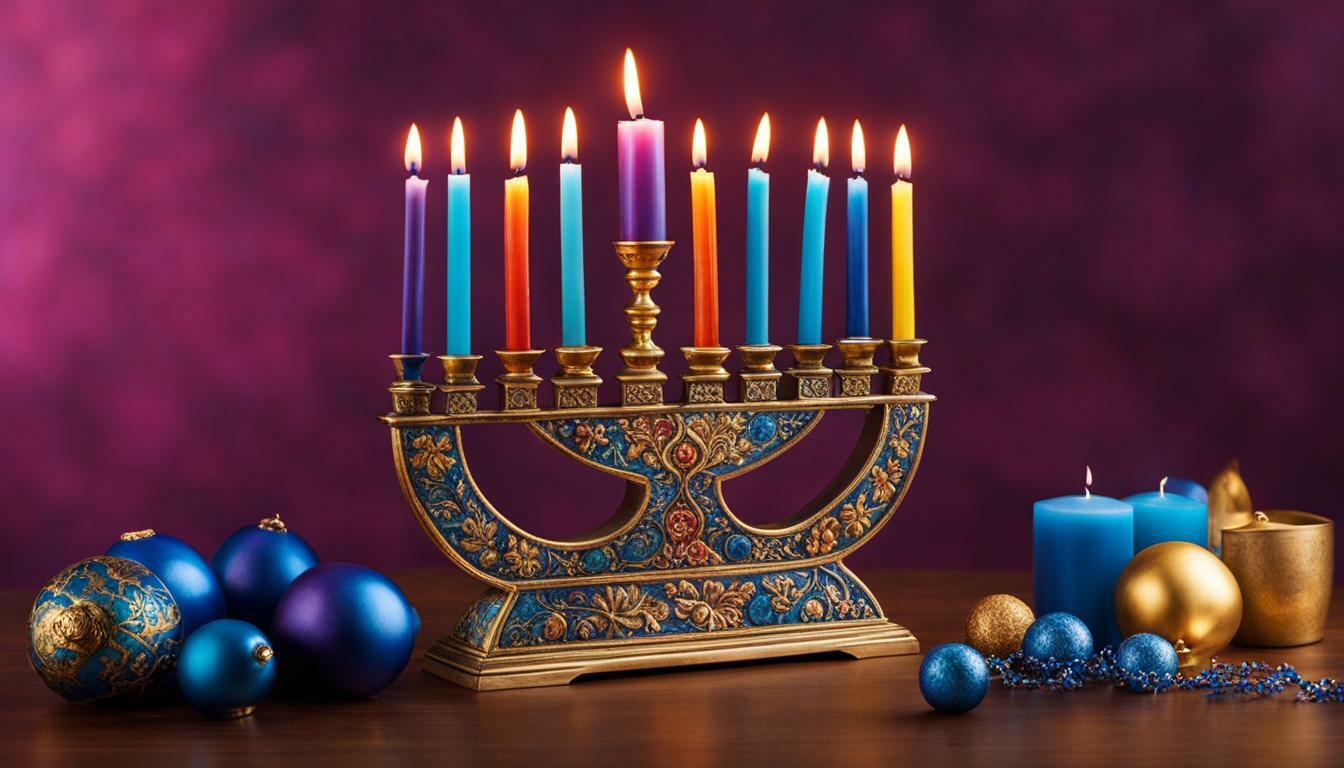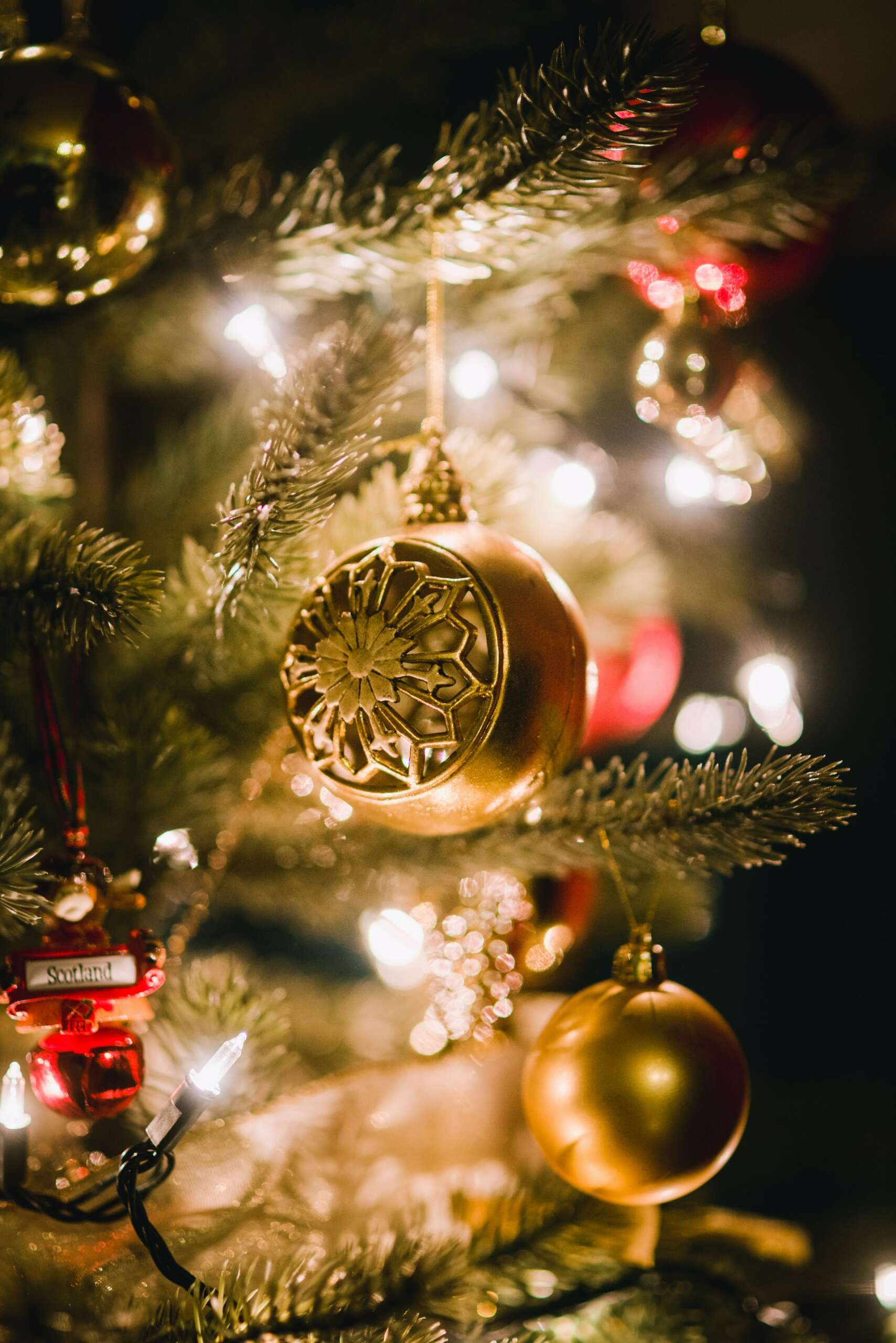As one of the most significant Jewish holidays, Hanukkah is a time for celebration and reflection. Also known as the “Festival of Lights,” Hanukkah is steeped in rich traditions and history that have been passed down for generations.
From lighting the menorah to playing dreidel games and indulging in delicious latkes, Hanukkah is a time to come together with family and friends and appreciate the cultural roots of this joyous occasion. In this article, we will explore the origins of Hanukkah, unravel its many traditions, and share authentic recipes to make your celebrations even more special.
- Hanukkah is a significant Jewish holiday that celebrates Jewish history and traditions.
- The menorah, dreidel, and latkes are all central to Hanukkah traditions and celebrations.
- Hanukkah commemorates the victory of Judah Maccabee and the miracle of the oil.
- Hanukkah is celebrated around the world, with unique cultural elements and traditions in each location.
- Engaging children in Hanukkah celebrations through crafts and storytelling can foster a deeper understanding and appreciation of this special holiday.
The Origins of Hanukkah
Hanukkah is a Jewish holiday that commemorates the victory of the Maccabees against the Syrian-Greek army and the rededication of the Holy Temple in Jerusalem. The Jewish people had been forbidden to practice their religion and were forced to worship Greek gods. Led by Judah Maccabee, a small group of Jews rose up in rebellion and successfully defeated their oppressors.
Following the victory, the Jews purified the temple and relit the menorah, but only had enough oil to last for one day. Miraculously, the oil burned for eight days, allowing enough time to prepare more oil. This miracle of the oil is a significant aspect of the Hanukkah story and is celebrated each year by lighting the menorah for eight consecutive nights.
Hanukkah is not one of the Biblically mandated Jewish holidays but holds great significance in Jewish history and culture. The holiday falls on the 25th day of the month of Kislev, which typically falls in December on the Gregorian calendar.

The story of Hanukkah began in 168 BCE when the Syrian-Greek King Antiochus IV Epiphanes began a campaign to spread Greek culture and religion throughout the lands he had conquered, including the land of Israel. The Jews were forbidden from practicing their religion and were forced to worship idols and Greek gods. The Temple in Jerusalem was desecrated, and the Jewish people were oppressed.
In 167 BCE, a group of Jewish rebels, led by Judah Maccabee, rose up against the Syrian-Greek forces and were initially successful in driving them out of Jerusalem. After reentering the Holy Temple, the Maccabees found only enough oil to light the menorah for one day. Miraculously, the oil lasted for eight days, allowing the Jews to rededicate the Temple and celebrate Hanukkah, the Festival of Lights, for eight days and nights.
The Festival of Lights
Hanukkah, also known as the Festival of Lights, is a Jewish holiday that commemorates the miracle of the oil that burned for eight days in the Temple. The holiday lasts for eight nights, during which families light the menorah each evening. The menorah is an eight-branched candelabrum, with an additional ninth candle used to light the others. This central tradition of Hanukkah represents the triumph of light over darkness, hope over despair, and freedom over oppression.
The menorah is lit each night, with an additional candle added each evening, until all eight candles are burning brightly on the final night of Hanukkah. The central candle, known as the shamash, is used to kindle the other candles. It is placed in the center of the menorah and lit first, symbolizing the power to ignite others and spread light into the world.
The lighting of the menorah is accompanied by the singing of traditional Hanukkah songs, such as “Maoz Tzur” and “Hanerot Halalu,” further adding to the joyful atmosphere of the holiday. Families also exchange small gifts, often in the form of Hanukkah gelt (chocolate coins), and play games with a dreidel, a four-sided spinning top.

As the holiday of Hanukkah approaches, families prepare for its arrival by gathering the necessary items. This includes a hanukkiah (Hanukkah menorah), candles, dreidels, and gelt. Hanukkah decorations, such as blue and silver garlands and Stars of David, can also be seen in homes and public areas during this time.
The Festival of Lights is a beautiful celebration of hope, joy, and freedom, and its traditions continue to be cherished by families around the world.
Hanukkah Traditions
Hanukkah traditions hold special significance for the Jewish community around the world. They reflect the rich heritage and cultural practices of this community. Some of the most popular Hanukkah traditions include:
| Hanukkah Menorah | The Dreidel | Gift-Giving |
|---|---|---|
 |
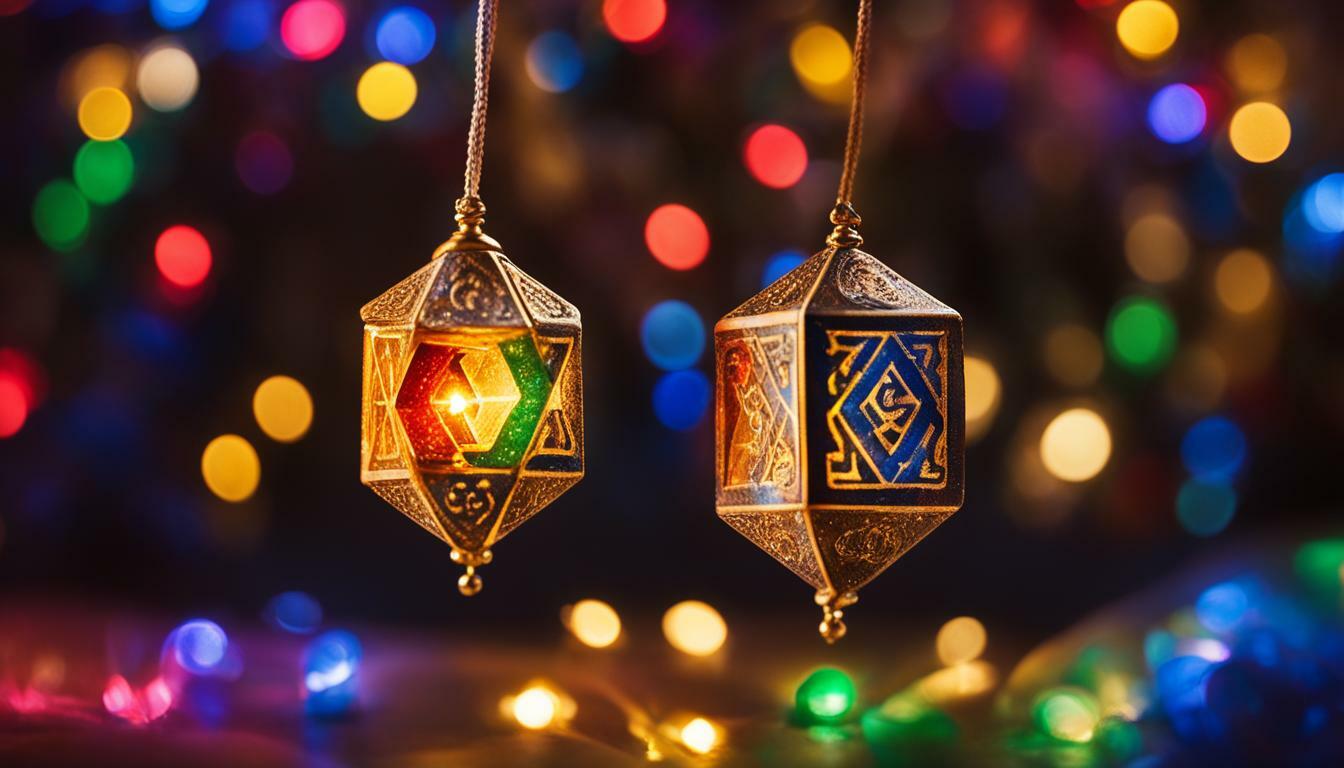 |
 |
| The menorah is a central tradition during Hanukkah. It is a nine-branched candelabrum that represents the miracle of the oil that lasted for eight days. Each night, one additional candle is lit with a shamash candle that is used to light the other candles. The menorah is placed in a central location in the home, and the candles are lit in the evening. | The dreidel is a spinning top game that is played during Hanukkah. It has four sides, each marked with a Hebrew letter: Nun, Gimel, Hei, and Shin. The letters represent “A Great Miracle Happened Here,” which is a reference to the miracle of the oil. Players use nuts, candies, or coins to bet on the outcome of the spin. | Gift-giving is also a significant part of Hanukkah celebrations. Children receive small gifts each night, and families exchange presents throughout the holiday. Traditional Jewish gifts include dreidels, menorahs, and gelt (chocolate coins). |
Hanukkah traditions have evolved over time, but they continue to provide a sense of community and belonging for Jewish families around the world. By passing down these customs to future generations, they ensure that the spirit of Hanukkah lives on.
Lighting the Menorah
The lighting of the menorah is perhaps the most well-known and widely followed tradition of Hanukkah. The menorah is a nine-branched candelabrum that represents the miraculous oil that burned for eight days in the Temple after the Maccabees’ victory over the Greeks.
The menorah is usually placed in a prominent location, such as a window, so that it can be seen by passersby. Each night of Hanukkah, a new candle is lit, starting with the shamash, or helper candle, which is then used to light the first candle on the right-hand side of the menorah. On the second night, an additional candle is lit, and so on until all eight candles are burning on the final night of Hanukkah.
The lighting of the menorah is a simple yet powerful ritual that brings families and communities together. It serves as a reminder of the miracles that occurred during Hanukkah and the importance of preserving traditions for future generations.
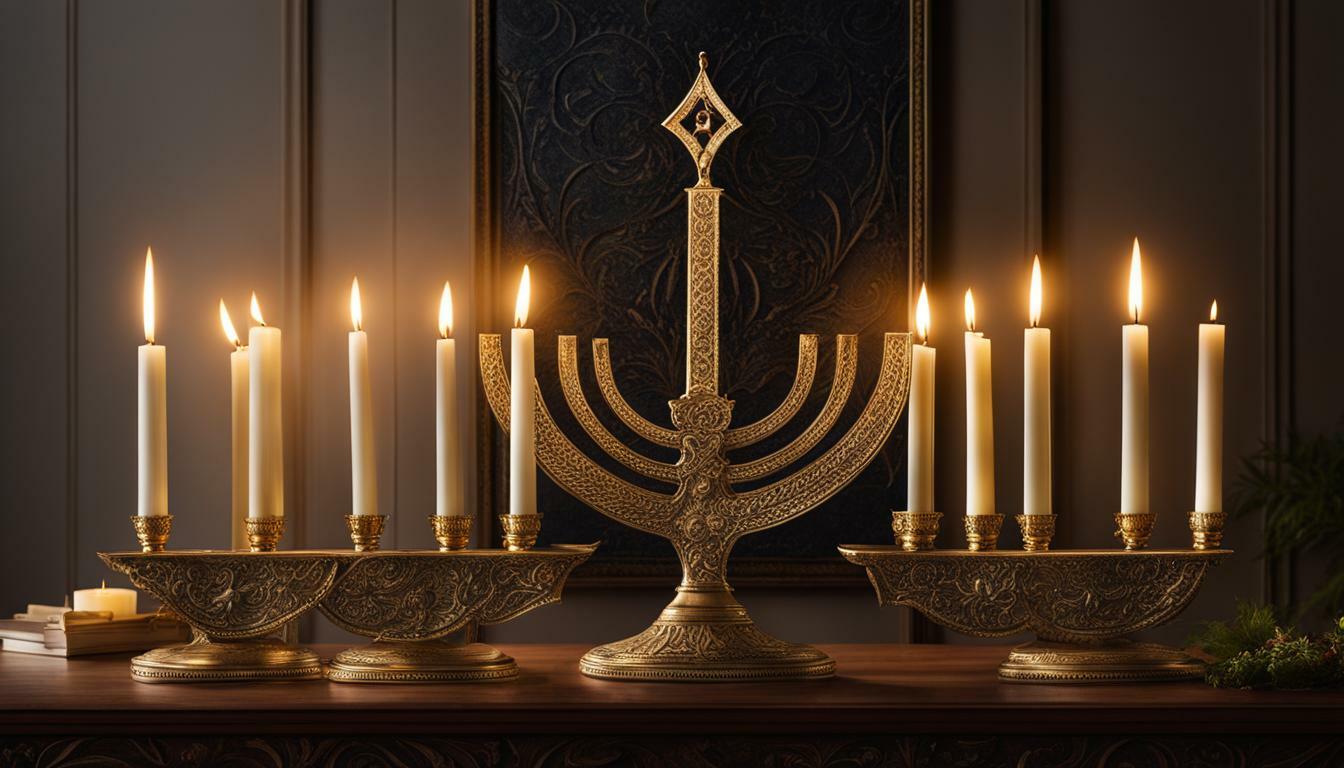
One of the most beloved Hanukkah traditions is playing the dreidel game. The dreidel, a four-sided spinning top, is typically made of wood, plastic, or clay and features Hebrew letters on each side. It is said that during the time of the Maccabean revolt, Jewish children would use the dreidel as a cover for studying Torah, as it was prohibited by the Greeks. Today, the dreidel game is enjoyed by children and adults alike during Hanukkah celebrations.
To play the game, each player begins with an equal number of game pieces, such as candies or gelt (chocolate coins). Players take turns spinning the dreidel and following the instructions based on which Hebrew letter is facing up. If the dreidel lands on the letter “nun,” the player does nothing. If it lands on “gimel,” the player takes all the game pieces from the pot. If it lands on “hey,” the player takes half of the pot. And if it lands on “shin,” the player must put one game piece into the pot. The game continues until one player has collected all the game pieces.
Playing dreidel games is a fun and engaging way to celebrate Hanukkah with friends and family. So gather your loved ones, grab some gelt, and let the spinning begin!
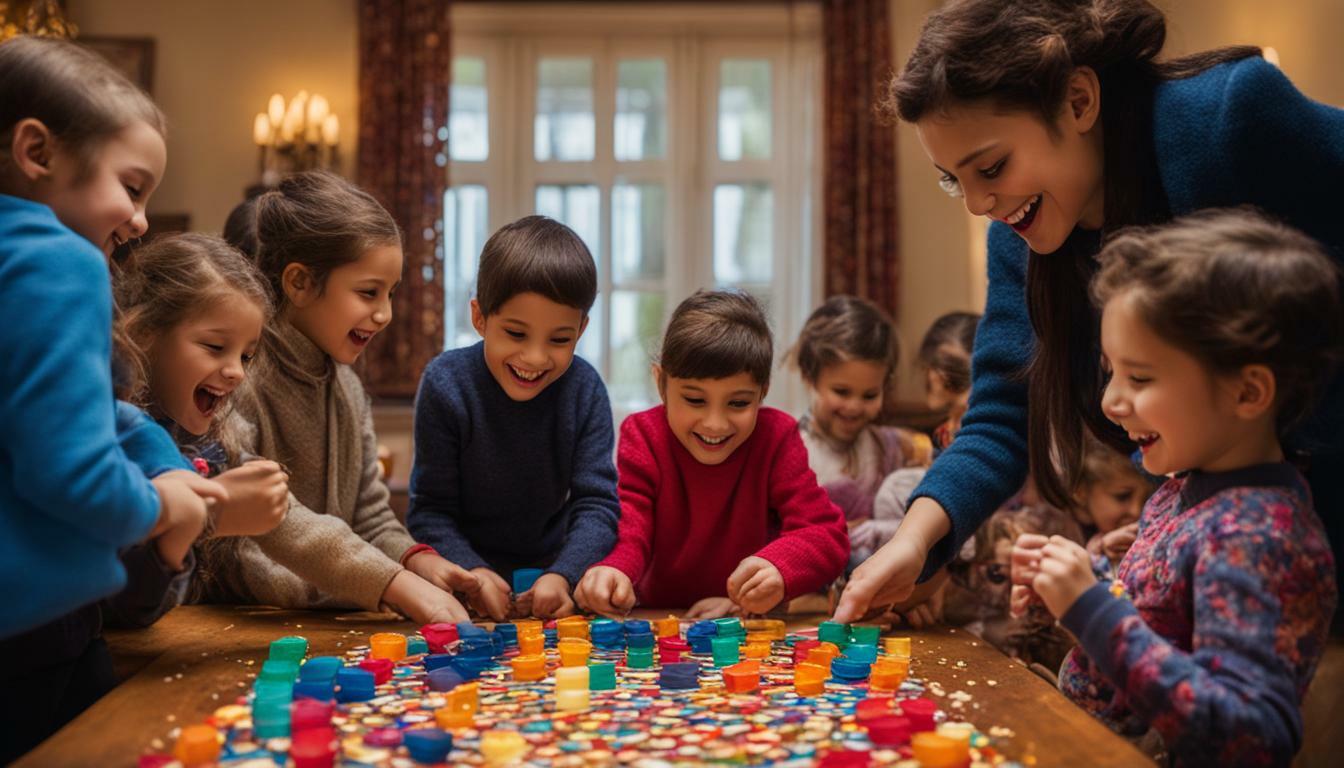
Indulge in the delicious culinary traditions of Hanukkah with these authentic recipes. One of the most popular Hanukkah dishes is latkes, crispy potato pancakes that are both savory and satisfying. To make these delectable treats, grate 3 large peeled potatoes and 1 small onion using a food processor or grater. Squeeze the excess liquid out of the grated mixture, then add 2 beaten eggs, 1/4 cup of flour, 1 teaspoon of salt, and 1/4 teaspoon of black pepper. Mix well, then heat up a 1/2 inch of oil in a frying pan on medium heat. Use a spoon to drop the latke batter into the hot oil, then fry until crispy and golden brown. Serve hot with applesauce and sour cream.

Another popular Hanukkah treat is sufganiyot, or jelly-filled doughnuts. To make these sweet pastries, dissolve 2 1/4 teaspoons of dry yeast in 1/4 cup of warm water and set aside. In a separate bowl, mix 3 cups of flour, 1/4 cup of sugar, 1 teaspoon of salt, and 1/2 teaspoon of cinnamon. Add the yeast mixture, 2 beaten eggs, and 1/4 cup of melted butter, and mix until smooth. Cover with a towel and let rise for 1 hour. Roll out the dough to 1/4 inch thickness, then cut out circles using a cookie cutter. Let the dough circles rise for another 30 minutes, then fry in hot oil until golden brown. Once cooled, fill each pastry with your favorite jelly using a pastry bag and a small tip. Dust with powdered sugar and enjoy!
These traditional Hanukkah foods are delicious and easy to make, adding to the festive atmosphere of your celebration. Try out these recipes and share the joy of Hanukkah with your family and friends.
Symbols and Decorations
Hanukkah is a festival of lights and symbols. Many traditional Hanukkah symbols are used to decorate homes and synagogues during the holiday. The most important of these symbols is the menorah, which is used to celebrate the miracle of the oil that kept the Temple’s menorah burning for eight days instead of one. Other popular symbols associated with Hanukkah include the Star of David, which is a six-pointed star used to represent the Jewish faith, and the dreidel, a spinning top game that is played during the holiday.
The colors blue and silver are commonly used to decorate during Hanukkah. This color combination is often found on Hanukkah-themed wrapping paper, ornaments, and decorations. Hanukkah gelt, or chocolate coins wrapped in shiny foil, are another popular decoration. These candies are often used in games of dreidel, and they can also be used to decorate Hanukkah tables.
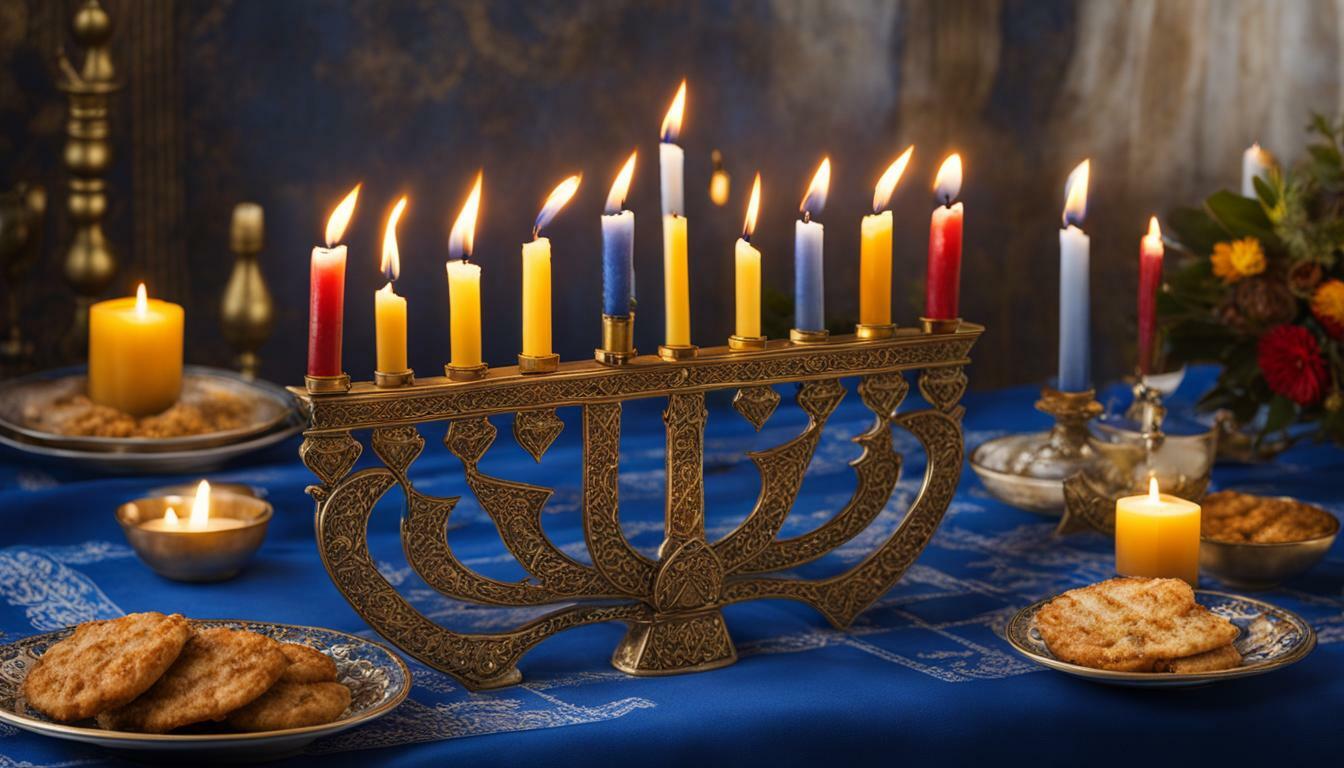
The Hanukkah menorah, also known as a hanukkiah, is an important symbol of the holiday. It has nine branches, one for each night of Hanukkah and a central branch called the shamash. The shamash is used to light the other candles, and it is always placed above or below the other branches to distinguish it from the rest.
Decorating for Hanukkah is an important part of the holiday celebrations. Whether you choose to use traditional Hanukkah symbols or more modern decorations, your home will be filled with light and joy during this special time of year.
Hanukkah for Children
One of the most cherished aspects of Hanukkah is passing down traditions to younger generations. From lighting the menorah to making latkes, children play a central role in the holiday celebration. Here are some ideas for involving children in the festivities:
- Storytelling: Share the story of Hanukkah with children through age-appropriate books and stories. Teach them about the brave Judah Maccabee and the miracle of the oil.
- Crafts: Encourage creativity with Hanukkah-themed crafts, such as making menorahs out of paper or decorating dreidels with paint or markers.
- Dreidel Games: Teach children the rules of the dreidel game and enjoy playing together as a family. Make it even more fun by using chocolate coins (Hanukkah gelt) as game pieces.
- Cooking: Have children help prepare traditional Hanukkah foods, such as latkes or sufganiyot. Not only will they learn valuable kitchen skills, but they’ll also take pride in contributing to the celebration.
By involving children in Hanukkah traditions, you’ll not only create cherished memories but also instill a sense of cultural pride and understanding.
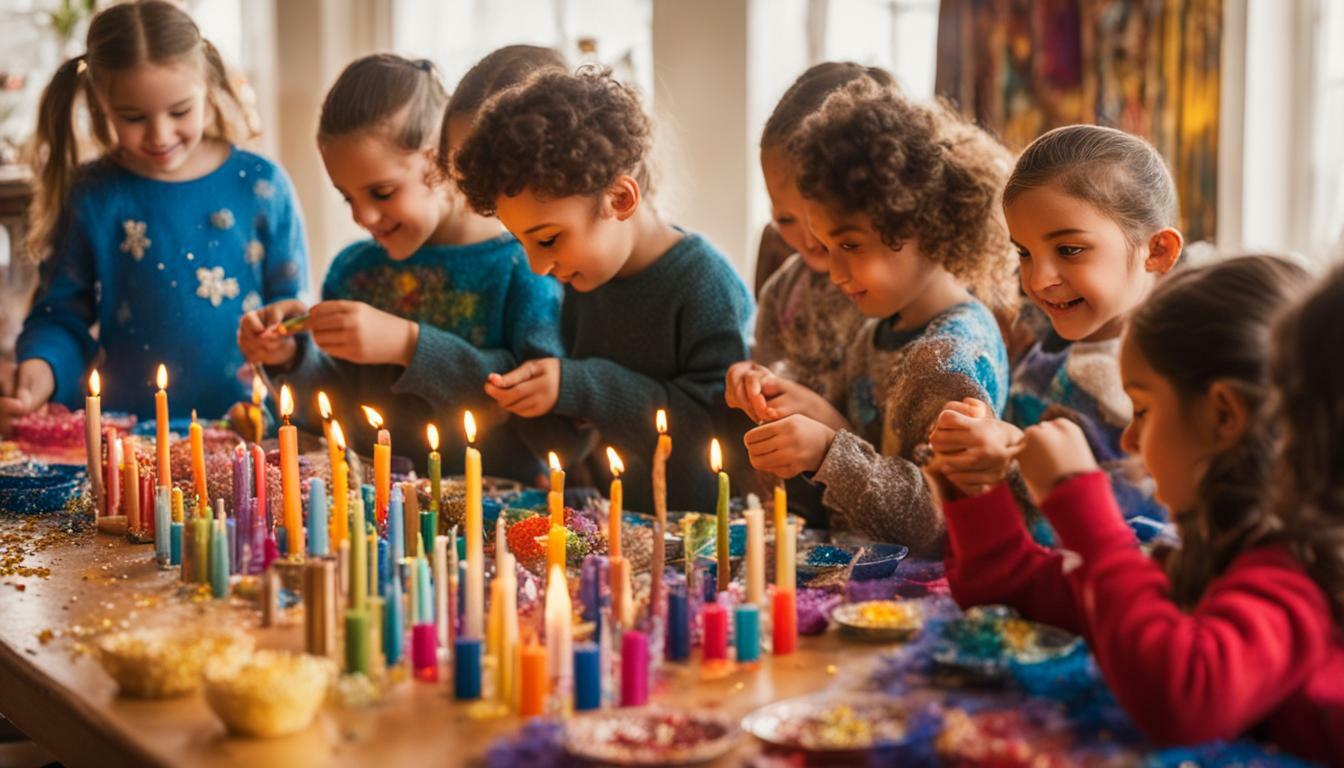
Israel is the birthplace of Hanukkah, and thus, it is celebrated with great enthusiasm and fervor here.
The country lights up during Hanukkah, with the menorah being lit in public places, such as the Western Wall in Jerusalem, and on the tops of cars and buses.
One of the unique traditions in Israel is the daily lighting of the menorah at the Western Wall, one of Judaism’s holiest sites. Thousands gather to witness this beautiful sight and celebrate the miracle of the oil.
Another special feature of Hanukkah in Israel is the abundance of sufganiyot, jelly-filled doughnuts. Israelis consume millions of these delicious treats during the holiday, with bakeries all over the country offering a variety of flavors and decorations, including gold and silver glitter.
Furthermore, Hanukkah in Israel is a time for reunions and family gatherings. Schools close for the week, and many people take time off work to be with their loved ones.
The Hanukkah Dreidel in Israel
Another popular tradition in Israel is playing dreidel, a four-sided spinning top with Hebrew lettering. Along with the typical letters, which stand for the phrase “A Great Miracle Happened There” (referring to the miracle of the oil), Israeli dreidels have a fifth letter, “P”, which stands for “Here.”
This represents the fact that Israel is the land where the miracle happened, emphasizing the special connection between the country and the holiday.
Whether you’re in Jerusalem or Tel Aviv, celebrating Hanukkah in Israel is a truly special experience that showcases the rich history and traditions of this joyous holiday.
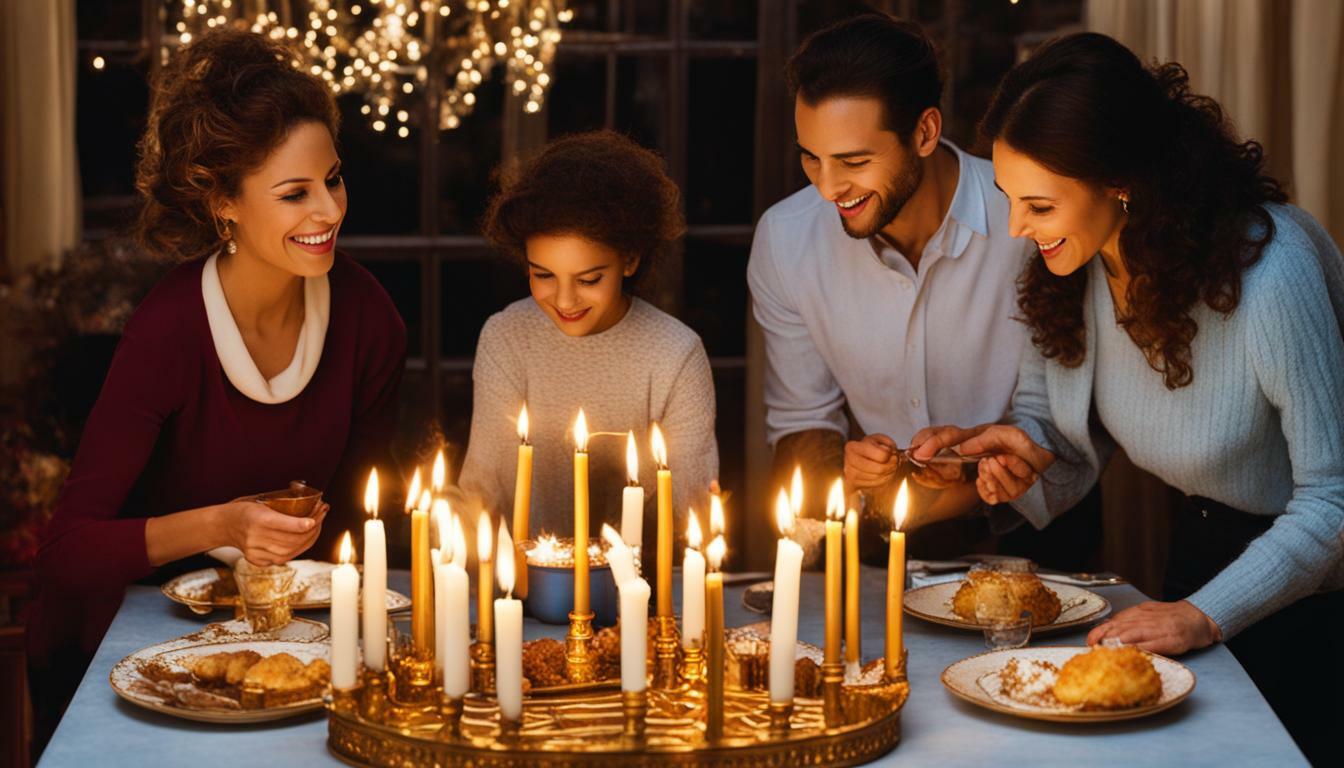
Hanukkah is a beloved holiday celebrated by Jewish communities around the world. While the traditions and customs of the holiday remain consistent, each community adds its unique flavor to the celebration.
In Israel, Hanukkah is a particularly special time. The country buzzes with excitement as the eight-day festival begins. The streets are adorned with festive Hanukkah lights, and people gather to light their menorahs and sing traditional songs. Hanukkah in Israel is a time for food, family, and joy.
Across the Atlantic, in the United States, Hanukkah is a time for gift-giving and community events. Many American cities host Hanukkah festivals, featuring holiday foods, music, and games. Families gather to exchange gifts and light the menorah together.
Europe also has its unique way of celebrating Hanukkah. In Italy, for example, Jews light menorahs in their windows to show their presence and pride in their community. In France, special Hanukkah candies called “bugnes” are enjoyed by adults and children alike.
Asia and Africa also have their own traditions for Hanukkah celebrations. In India, Jews celebrate Hanukkah by lighting lanterns called “diam” and by exchanging gifts of dried fruit and nuts. In Ethiopia, Hanukkah is known as “Sigd” and is celebrated with traditional food, dancing, and ceremonies.
Wherever you are in the world, Hanukkah is a time to come together with family and friends, to celebrate the miracle of the oil and the triumph of light over darkness. Happy Hanukkah!
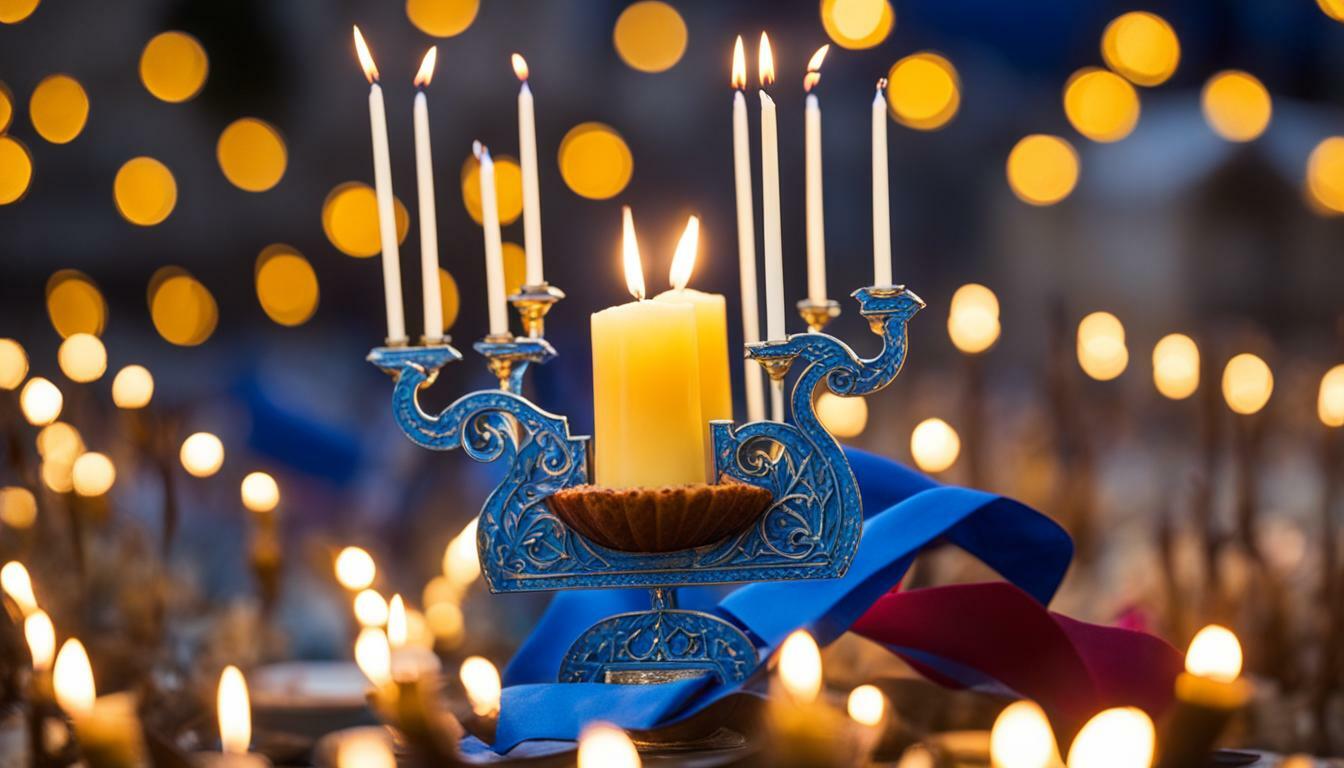
Celebrate Hanukkah with fun and creative DIY crafts and decorations that will add a personal touch to your holiday festivities. From menorah candle holders to dreidel garlands, the possibilities are endless. Get your family involved and enjoy some quality time together while creating memorable decor.
Hanukkah Menorah Candle Holders
Add some sparkle to your Hanukkah celebration with these beautiful DIY Hanukkah menorah candle holders. All you need are some glass jars, tissue paper, glue, and glitter. Start by cutting the tissue paper into small squares and gluing them onto the jars. Then, sprinkle glitter over the tissue paper and let it dry. Once dry, place a small candle in each jar and enjoy the festive glow. An excellent craft for children and adults alike!
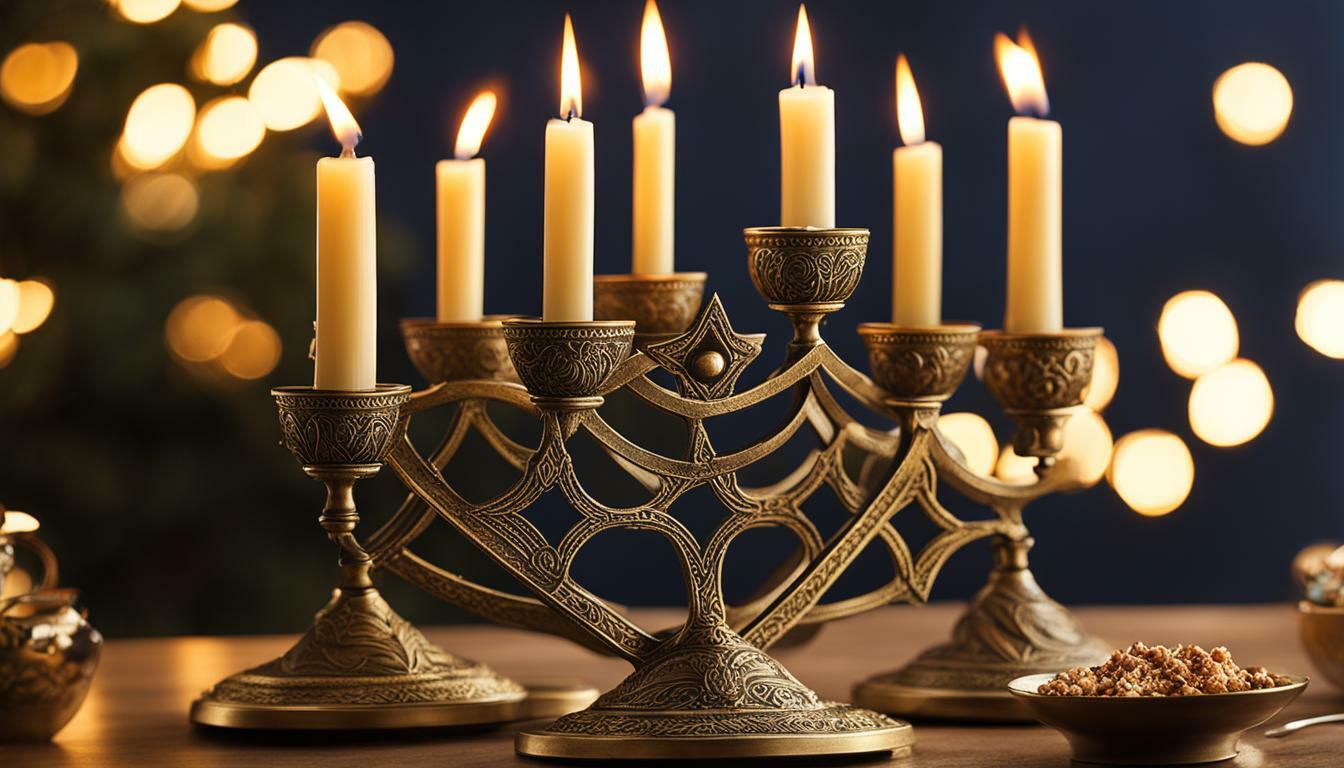
String together a colorful dreidel garland to add some Hanukkah cheer to your home. Start by cutting out dreidel shapes from colored paper or cardstock. Then, punch a hole in the top of each dreidel and thread them onto a string or ribbon. You can also add some glitter or paint to make them more festive. Hang your garland in a prominent place to brighten up any room!
Star of David Wreath
Make a stunning Star of David wreath using materials such as felt, cardboard, and ribbon. Cut out several Star of David shapes from felt and attach them to a circular cardboard base. Add some ribbon or twine to hang it up, and you have a unique and beautiful decoration for Hanukkah.
Handmade Hanukkah Cards
Spread some holiday cheer by creating your own handmade Hanukkah cards. Use cardstock, markers, glitter, and other embellishments to make them unique. You can also add some personal touches such as family photos or special messages. It’s a simple yet thoughtful way to show your loved ones you care.
There you have it! Try out these Hanukkah crafts and DIY decorations to make your holiday celebration even more special and memorable.
Making Hanukkah a Memorable Celebration
As we have explored in this article, Hanukkah is a joyous Jewish holiday that celebrates the victory of Judah Maccabee and the miracle of the oil. From lighting the menorah to playing dreidel games and indulging in delicious Hanukkah foods, there are many traditions that make this holiday special.
To make your Hanukkah celebration truly memorable, consider incorporating some of the customs and ideas we have discussed. Whether it’s crafting DIY decorations, involving children in the festivities, or exploring the diverse ways Hanukkah is celebrated around the world, there are countless ways to make this holiday meaningful and enjoyable for everyone.
In addition, take time to reflect on the significance of Hanukkah and what it represents. This holiday is not only a time for celebration, but also a time for gratitude, community, and resilience. As we light the menorah each night and gather with loved ones, let us remember the blessings that surround us and the strength of our traditions.
We hope that this article has inspired you to embrace the spirit of Hanukkah and make this year’s celebration one to remember. From all of us at [Publication Name], we wish you a happy and meaningful Hanukkah celebration filled with love, joy, and peace.
FAQ
Q: What is Hanukkah?
A: Hanukkah is a Jewish holiday that celebrates the victory of Judah Maccabee and the miracle of the oil. It is also known as the Festival of Lights.
Q: What are the traditions associated with Hanukkah?
A: Hanukkah traditions include lighting the menorah, playing dreidel games, singing traditional songs, and exchanging gifts.
Q: Can you explain the significance of lighting the menorah?
A: Lighting the menorah during Hanukkah symbolizes the miracle of the oil that lasted for eight days in the ancient Temple. The central shamash candle is used to kindle the other candles.
Q: How do you play dreidel?
A: Dreidel is a spinning top game played during Hanukkah. Each player spins the dreidel and performs actions based on the Hebrew letters on its sides.
Q: What are some traditional Hanukkah foods?
A: Traditional Hanukkah foods include latkes (potato pancakes), sufganiyot (jelly-filled donuts), and other delicious treats.
Q: What are some symbols and decorations associated with Hanukkah?
A: Symbols and decorations of Hanukkah include the Star of David, Hanukkah gelt (chocolate coins), and the colors blue and silver.
Q: How can I involve children in the Hanukkah celebration?
A: There are various ways to involve children in Hanukkah, such as crafts, storytelling, and age-appropriate activities that teach them about the holiday’s significance.
Q: How is Hanukkah celebrated in Israel?
A: Hanukkah in Israel is celebrated with special events, traditions, and cultural elements that highlight the holiday’s importance in the country’s history and culture.
Q: How is Hanukkah celebrated around the world?
A: Hanukkah is celebrated differently in various parts of the world, showcasing the diversity and richness of Jewish traditions.
Q: Are there any Hanukkah crafts and DIY decorations?
A: Yes, there are exciting Hanukkah crafts and DIY decoration ideas available, such as making menorah candle holders, dreidel garlands, and other beautiful crafts to enhance your celebration.
Q: How can I make Hanukkah a memorable celebration?
A: By incorporating the traditions, recipes, and cultural aspects discussed in this article, you can create a memorable and meaningful Hanukkah celebration.


